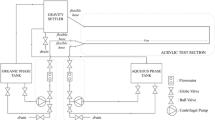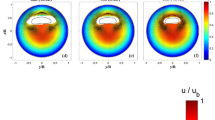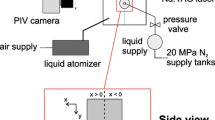Abstract
An investigation of dispersed liquid–liquid two-phase turbulent swirling flow in a horizontal pipe is conducted using a particle tracking velocimetry (PTV) technique and a shadow image technique (SIT). Silicone oil with a low specific gravity is used as immiscible droplets. A swirling motion is given to the main flow by an impeller installed in the pipe. Fluorescent tracer particles are applied to flow visualization. Red/green/blue components extracted from color images taken with a digital color CCD camera are used to simultaneously estimate the liquid and droplet velocity vectors. Under a relatively low swirl motion, a large number of droplets with low specific gravity tend to accumulate in the central region of the pipe. With increasing droplet volume fraction, the liquid turbulence intensity in the axial direction increases while that in the wall-normal direction decreases in the central region of the pipe. In addition, the turbulence modification in the present flow is strongly dependent on the droplet Reynolds number; however, the interaction of droplet-induced turbulences is significant due to vortex shedding, particularly at high droplet Reynolds numbers and higher droplet volume fraction.
















Similar content being viewed by others
References
Goto M, Matsukura N, Hagiwara Y (2005) Heat transfer characteristics of warm water flow with cool immiscible droplets in a vertical pipe. Exp Therm Fluid Sci 29:371–381
Inaba H, Horibe A, Ozaki K, Yokoyama N (2000) Liquid–liquid direct contact heat exchange using a perfluorocarbon liquid for waste heat recovery (heat transfer characteristics obtained with perfluorocarbon droplets descending in a hot water medium). JSME Int J Ser B 43(1):52–61
Ishikawa M, Murai Y, Wada A, Iguchi M, Okamoto K, Yamamoto F (2000) Novel algorithm for particle tracking velocimetry using the velocity gradient tensor. Exp Fluids 29(6):519–531
Jacobs HR, Golafshani M (1989) A heuristic evaluation of the governing mode of heat transfer in a liquid–liquid spray column. ASME J Heat Transf 111:773–778
Kaviany M (1994) Principals of convective heat transfer. Springer, Heidelberg, pp 417–425
Kitagawa A, Hishida K, Kodama Y (2005) Flow structure of microbubble-laden turbulent channel flow measured by PIV combined with the shadow image technique. Exp Fluids 38(4):466–475
Kitoh O (1991) Experimental study of turbulent swirling flow in a straight pipe. J Fluid Mech 225:4454–4479
Kouda T, Hagiwara Y (2006a) Turbulent swirling water flow with oil droplets. Multiphase Sci Technol 18(1):55–72
Kouda T, Hagiwara Y (2006b) An experimental study on turbulent swirling water flow with immiscible droplets. Int J Heat Fluid Flow 27:611–618
Mittal R (2000) Response of the sphere wake to freestream fluctuations. Theor Comp Fluid Dyn 13:397–419
Otsu N (1979) A threshold selection method from gray-level histograms. IEEE Trans Syst Man Cybern SMC 9(1):62–66
Sakamoto H, Haniu H (1990) A study on vortex shedding from spheres in a uniform flow. ASME J Fluids Eng 112:386–392
Sugioka K, Komori S (2005) Drag and lift forces acting on a spherical droplet in homogeneous shear flow (in Japanese). Trans JSME 71B:7–14
Takehara K, Etoh T (1999) A study on particle identification in PTV. J Vis 1(3):313–323
Yamamoto F, Wada A, Iguchi M, Ishikawa M (1996) Discussion of the cross-correlation methods for PIV. J Flow Vis Image Process 3(1):65–78
Author information
Authors and Affiliations
Corresponding author
Rights and permissions
About this article
Cite this article
Kitagawa, A., Hagiwara, Y. & Kouda, T. PTV investigation of phase interaction in dispersed liquid–liquid two-phase turbulent swirling flow. Exp Fluids 42, 871–880 (2007). https://doi.org/10.1007/s00348-007-0291-5
Received:
Revised:
Accepted:
Published:
Issue Date:
DOI: https://doi.org/10.1007/s00348-007-0291-5




